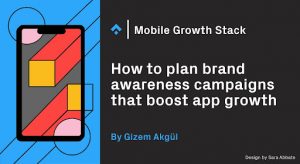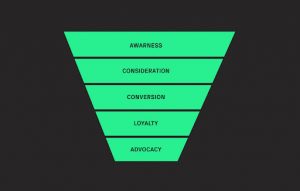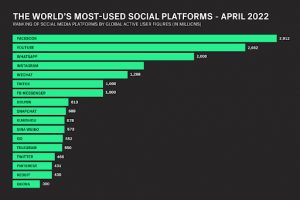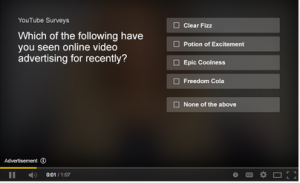
While its exact definition is recognition of a brand from a customer, brand awareness stands at the very top of the conversion funnel. It’s the first point of contact in the process of attracting users to download your app, purchase your product or subscribe to your service. It is the first hurdle all brands must face in order to succeed in brand advocacy which is the end goal of the funnel and it’s when users are loving, supporting, and promoting your product or service. While you can achieve brand awareness through organic social media reach, viral content, and/or offline events, paid social media campaigns are certainly the most controlled, thorough, and measurable way to do it.

Considering that a single user spends an average of 147 minutes a day on social media and there are 4.62 billion people using social media worldwide, it can be effective to utilize ad platforms such as YouTube, Facebook, TikTok, or Snapchat to establish controlled and measurable brand awareness.
From an acquisition perspective, some, usually newer companies tend to be hesitant when investing in brand awareness due to not being able to see an immediate impact in the same way they would with performance campaigns. This is because the goal of digital brand awareness campaigns is to push impressions, reach, and clicks. The goal is at a higher level, and therefore leaves less of an impression than seeing sign-ups, purchases, or first deposits. However, it’s important to acknowledge that brand awareness campaigns serve a long-term impact, making your brand’s competitive advantages known, helping lower acquisition costs, and affecting the lifetime value of users positively.
Planning a campaign (with best practices)
Brand awareness campaigns in essence should be very strategic and efficient. This means you should try to impact as many people as possible at the lowest possible cost. Creating a media plan for brand awareness campaigns also heavily depends on what stage your brand is at and your objectives. In general, using a combination of different platforms, campaign objectives, creatives, and targeting options is the smartest way to start off. You will be able to quickly see what works best for your audience and brand, generate learnings and optimize accordingly.
- Choosing the right platforms: Platforms with the most users such as Facebook (2.9B reach), YouTube (2.5B reach), Instagram (1.5B reach), TikTok (1B reach), Snapchat (589M reach), and Twitter (465M reach) are great platforms to evaluate for your needs and target audience. Facebook and Instagram have the largest combined reach while users tend to spend more time on TikTok, Snapchat, and Twitter. Depending on your budget, we recommend using 2-3 different platforms simultaneously to increase the chances of reaching the right audience at a low cost.
Example: If you’re planning a brand awareness campaign for a trendy clothes shopping app, it would make sense for you to reach your audience on TikTok and Snapchat while a current affairs app might find a more receptive audience on Twitter.
Tip: We recommend reaching out to your channel reps, or doing research on platforms such as Statista and eMarketer if you don’t have channel reps, for benchmarks on CPM, CPC, or estimated reach in your industry when you’re deciding on what platforms to utilize for your branding needs.

Source:HootSuite
- Campaign Duration: It’s essential to keep the campaigns running for at least 2 weeks to measure impact. Longer than that, the timeline depends on your budget, objectives, and brand. If your budget allows, try to have an always-on branding campaign running to continuously support the funnel in order to keep the flow of users coming in that you can target later on. Always-on campaigns are also helpful to get your competitive advantages across to more people at a lower cost than your performance campaigns so it might be helpful to keep running them to lower your overall CPMs down.
Tip: To see a bigger collective impact, plan the launch of your brand awareness campaigns in a peak season, such as the launch of a new product or rebrand. Support your brand awareness campaign with a boost of bids and budgets in your performance campaigns.
- Choosing the right campaign objective: Brand awareness campaign objectives can be split into two broad categories: Reach campaigns and Traffic campaigns. Reach campaigns ensure you reach the most number of people at the lowest possible cost, while traffic campaigns will drive traffic to your landing page. Checking which advertising objectives are available on the platforms you want to run on is the first step in choosing the right campaign.
- Targeting: There are 3 main types of targeting you can use for branding campaigns:
- Contextual targeting is where you target topics, YouTube channels, or keywords rather than audiences so your ads show in the context you chose, this works well on YouTube where it’ll make your ad seem more native and relative.
- Interest targeting has the broadest targeting of all, which helps you achieve lower CPM (Cost Per Mille), while lookalike audiences or more advanced options like custom segments on YouTube reach more relevant and engaged users at a higher CPM.
- While broad targeting might work better for a brand with mass appeal, lookalike or more targeted campaigns might work better to reach a niche audience. This is why it’s important to use multiple options to keep the costs low while keeping engagement and awareness high.
- Selecting the right creatives: The single most important best practice for brand awareness creatives is to include logos, brand colors, jingles, or watermarks early on in the video or prominently in the images. It would also be helpful to use catchy slogans or a special CTA for your brand to make your creatives more rememberable. While your creatives might be very attractive, including heavy and balanced branding is important for users to remember and recognize your brand. It’s crucial to create multiple creatives that you think might work for your brand. Test them out in combination with different targets to diversify your portfolio.
Examples of balanced brand awareness videos:
https://www.youtube.com/watch?v=GQQFPZ723oc
https://www.youtube.com/watch?v=yetFk7QoSck
https://www.youtube.com/watch?v=OiHy9NVXx4c&list=PLlXZh4sJtb8FeCuXyZ90OyUCkpfzs1GtI&index=7
https://www.youtube.com/watch?v=YrFrS4iRXr0
Tip: Researching best practices by platform such as image specifications, safe zones, or new ad features will be helpful to create custom assets for each platform. Also, while images are cheaper to show, videos will be more impactful and effective in getting your message across.
Tip: Pay close attention to your ad copy as it should differ from direct response copywriting. In direct response copy, you’re trying to push users to take immediate action. Brand awareness copy should be more subtle, reliable, and informative. We recommend involving your channel reps as much as possible, from conception to storyboards to reviewing the produced creatives before they go live.
How to optimize a campaign?
Optimizing brand awareness campaigns is a bit more tricky than performance campaigns as you don’t necessarily see any conversions or other actions to base your optimization on. It’s important to keep it simple by focusing on video view rates, CPM (Cost Per Mille), CPC (Cost Per Click), and CTR (Click Through Rate). Regularly assess which brings in the most clicks/views and which ones don’t. You can regularly pause out any low-performing assets or targets, isolate well-performing content to assign more ad budget to it or adjust bids on different locations, demographics, or devices. During the campaign, you can also ask your platform reps for support on optimization and benchmarks.
Next Steps
Once the campaigns have concluded, it’s time to measure. Keep in mind that brand awareness campaigns have more of a long-term impact rather than an immediate one. Also, it’s important to keep in mind that the larger the budget, the more significant any metric you’re measuring will be.
A few ways to measure the impact of a brand awareness campaign could be:
- Assessing uplift in brand search volume
- Checking app category ranking growth
- Using Google’s Brand Lift measurement to estimate the impact your YouTube campaigns created if your budget is eligible for Brand Lift.
- Analyzing social media follower counts
- Analyzing the traffic on your app listing page
- Plan and execute an offline awareness survey
- Perform an incrementality analysis

YouTube’s Brand Lift Survey
An additional benefit of brand awareness campaigns is that you now have a totally new set of audiences in your funnel, as well as their data. Utilizing the results of your brand awareness campaigns to push those users further down the funnel, is important when making the most out of your investment. Consider retargeting them in a conversion campaign to eventually convert them into loyal customers.
Conclusion
Creating a stream of brand awareness campaigns on social media is crucial to the ongoing success of any growing app. While there are best practices, the strategy for your brand awareness campaigns heavily depends on your industry, brand, objectives, and budget. We highly recommend always-on brand awareness campaigns but employing them around peak seasons (e.g. back to school season for a clothing brand or the start of a league for a sports radio) will be an efficient way to dip toes into digital brand awareness. Moreover, brands that tend to use offline marketing to create brand awareness should start looking into more measurable and impactful ways to market, which just might be paid brand campaigns on social media.
Before you go:
- Media Mix Modeling is a part of the Mobile Growth Stack, in light of the end of comprehensive user-level data with iOS14.
- Please make use of our Mobile Growth Stack Slack Stack channel to ask any questions about MMM and we’d love to answer them where we can.
- Check out our deep dive into the solutions offered by mobile measurement partners (MMPs) such as AppsFlyer, Adjust, Branch, Singular, Kochava, and Tenjin. We cover conversion value models, SKAN dashboards, and technical implementation guides for developers and marketers, and finish off with an impact summary across all the major ad networks such as Google, Facebook, Snapchat, TikTok, and Apple Search Ads.
Table of Contents















